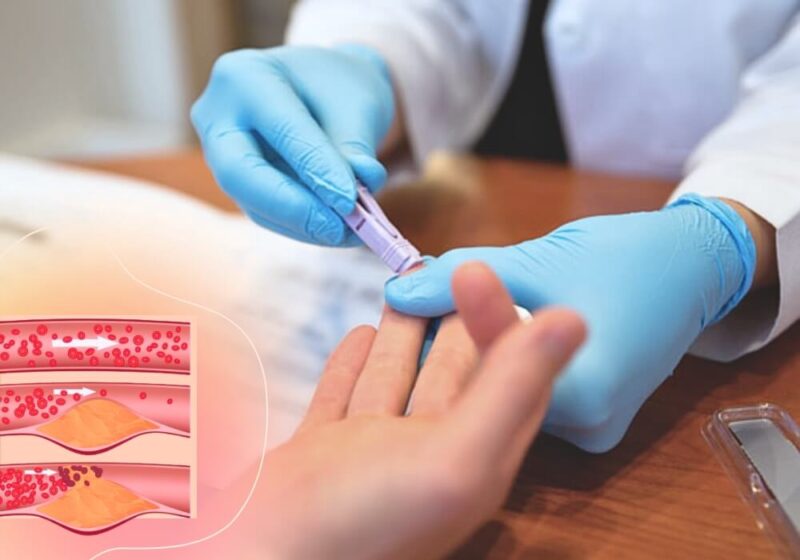Cholesterol: a health buzzword that you probably know is all about the food you eat and the genes you’ve got in your DNA. You’re likely aware that soaring cholesterol levels are far from ideal. Yet, amidst the vast array of nutrient deficiencies and bewildering health disorders, why should cholesterol reign supreme as one of our paramount health preoccupations?
The answer lies in the myriad of crucial tasks cholesterol takes on. It’s not just a hormone synthesizer or a cell constructor, oh no! Cholesterol is a bona fide essential component that we absolutely cannot survive without. Its presence, in just the right amount, is fundamental to our survival. Ensuring that our cholesterol levels are within the desired range is a cornerstone of optimal health. So, without further ado, let’s dive into the captivating world of cholesterol that you absolutely can’t afford to ignore!
From Food to Genes: Understanding the Intricacies of Cholesterol
Getting your cholesterol levels checked not only grants you access to the intricacies of your cardiovascular health. It also provides insight into those sneaky risk factors for heart disease. Getting a cholesterol test is like having a personal detective inspect your bloodstream, uncovering clues and whispers of potential health hazards. And fortunately, getting tested for cholesterol is a breeze!
To get your cholesterol tested, you can swing by your doctor’s office, where a quick blood draw unveils the secrets of your lipid profile. Or, if you fancy the cozy comfort of your own living quarters, there are home testing kits. By following the simple instructions on the kit, your samples can be whisked away to a laboratory for analysis.
How to Decode the Cholesterol Puzzle
Cholesterol test results are reported in two different units of measurement: milligrams per deciliter (mg/dL) or millimoles per liter (mmol/L). These numerical values work their mathematical magic, providing a quantitative assessment of the levels of cholesterol and triglycerides, which are types of fats found in the bloodstream that serve as forms of energy storage, swirling around in your blood.
Cholesterol test results will reveal the levels of your total cholesterol, triglycerides, LDL cholesterol, and HDL cholesterol. Aiming for the gold standard of cholesterol and triglyceride levels? Fear not, for specific ranges are here to guide you to a heart-healthy triumph:
- Total cholesterol: Below 200 milligrams per deciliter (mg/dL) is generally considered favorable.
- LDL cholesterol (often referred to as “bad” cholesterol): Ideally below 100 mg/dL.
- HDL cholesterol (the “good” cholesterol):
- Men: Aim for levels of 40 mg/dL or higher.
- Women: Aim for levels of 50 mg/dL or higher.
- Triglycerides: Recommended to keep levels below 150 mg/dL.
Consequences of Imbalanced Cholesterol and Triglyceride Levels
High cholesterol can significantly raise your risk of heart disease, including conditions such as coronary artery disease and peripheral artery disease. These agonizing conditions can impede blood flow, leading to reduced oxygen and nutrient supply to the heart and other organs. And if this wasn’t frightening enough, individuals with high cholesterol levels are also more susceptible to strokes and pancreatitis, an inflammation of the pancreas that can cause severe abdominal pain and digestive issues.
When your cholesterol is too low, you’re a sitting duck for cardiovascular diseases and strokes. Plus, low cholesterol can spark hormonal drama and even impact liver and gallbladder function. Your body also needs cholesterol to absorb certain vitamins. When levels are too low, your minerals may become less effective, impacting your overall health.
High levels of triglycerides contribute to the same smorgasbord of health issues as high cholesterol. These include heart disease, stroke, and a variety of other unwelcome party crashers. Low-level triglycerides aren’t all that innocent either. These can contribute to various underlying conditions such as nutritional deficiencies, hyperthyroidism, celiac disease, pancreatic insufficiency, liver disease, or inflammatory issues. Just like cholesterol, it’s a juggling act with triglycerides. Maintaining a balanced level is the secret to good health.
Understanding the Factors Behind Your Cholesterol Levels
Diet and nutrition are like the steering wheel to your cholesterol levels, driving them up and down depending on what nutrients you fuel your body with. Bite into foods high in saturated and trans fats, and whoosh—your LDL cholesterol levels zoom up faster than a loop-de-loop. But, couch potato-ing your way through life? That’s a one-way ticket to Cholesterol Imbalance Land, causing your LDL to shoot up and your HDL to plummet.
Genetic factors also play a crucial role in cholesterol regulation. They’re the unsung heroes of cholesterol regulation. In the spotlight is Familial hypercholesterolemia, an inherited condition that hampers your body’s cholesterol processing efficiency. If you’re a member of this exclusive club, your LDL cholesterol levels may be scaling the heights, setting you up for a less-than-thrilling encounter with heart disease. But with genetic testing and intervention, you could start managing your cholesterol levels as early as 20.
Crafting a Cholesterol-Balancing Diet
Step into the thrilling realm of heart-healthy cuisine, where each bite you savor is a stride towards achieving balanced cholesterol levels. Initiate your culinary journey by hosting a vibrant gathering of fruits and vegetables, complemented by nutritious whole grains and lean protein sources.
Awaken your plates with an enticing sizzle of exotic herbs and spices such as golden turmeric, bold garlic, and sweet cinnamon. These culinary champions not only bolster your health but also delight your taste buds. Round off your cholesterol-fighting feast with a splash of low-fat dairy, a sprinkle of nuts and seeds, and a cheeky nibble of dark chocolate. This flavorful assembly serves as your passport to a balanced, cholesterol-conscious lifestyle.
Incorporating monounsaturated and polyunsaturated fats into your diet is also great for your cholesterol levels. These elevate your HDL cholesterol levels, turning your body into a cholesterol-busting powerhouse. Here are some nutritious fats you should be welcoming onto your plate:
Monounsaturated Fats:
- Olive oil
- Avocados
- Nuts like almonds, peanuts, and cashews
- Seeds like sesame seeds and pumpkin seeds
- Peanut butter
- Canola oil
Polyunsaturated fats:
- Fatty fish like salmon, mackerel, and sardines
- Walnuts
- Flaxseeds
- Chia seeds
- Sunflower seeds
- Soybean oil
Elevate Your Workout Routine
Achieve optimal cholesterol health by embracing a variety of exercises. Emphasize the classics like running, cycling, swimming, and aerobics. Or take your fitness journey to new heights by infusing an electrifying blend of interval, strength, and circuit training. Feel the rush as you conquer sprint intervals, Tabata workouts, weightlifting, and bodyweight exercises, all while fueling your endurance through cardio strength training. By revitalizing your cardiovascular system, these dynamic workouts play a pivotal role in maintaining healthy cholesterol levels.
Lifestyle Modifications for Optimal Health
Embracing a few key lifestyle changes can wield a powerful influence on cholesterol levels. If you’re a smoker, liberating yourself from the clutches of this harmful habit is highly recommended, as smoking can impede HDL cholesterol and inflict damage on your blood vessels. When it comes to alcohol, navigating intake can be a delicate balancing act: women are often encouraged to savor just a single drink a day, while men can indulge in up to two. But for those battling high cholesterol, a resolute farewell to alcohol may be your ticket to optimal health.
Safeguarding Your Cardiovascular Health with Cholesterol Tests
Regular cholesterol testing and comprehending the results are crucial for maintaining optimal cardiovascular health. It is recommended to undergo testing every 4 to 6 years, or annually for higher-risk individuals, to stay well-informed about your cholesterol levels and make informed decisions regarding your overall health.
By embracing essential lifestyle modifications and seeking guidance from medical experts, you can fortify your well-being and significantly reduce the risk of heart-related complications. Prioritizing cholesterol health and taking proactive steps empowers individuals to pave their own path towards a future brimming with heart-healthy vitality.

